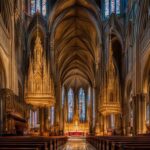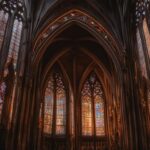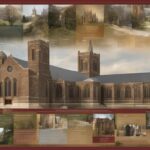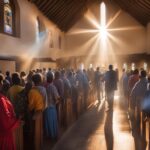Modern Church Architecture is a testament to the innovative and contemporary designs that have emerged in recent years. From mid-century modernist influences to cutting-edge structures, churches have embraced modernity while still serving as places of worship. In this article, we will delve into the world of modern church architecture, exploring the unique styles and elements that make them truly remarkable.
Key Takeaways
- Modern Church Architecture represents a departure from traditional design norms.
- Contemporary churches incorporate minimalist and sustainable elements.
- Mid-century modernist churches challenged traditional styles and embraced innovation.
- Some modern churches successfully blend modernist principles with traditional elements.
- Contemporary church designs continue to push boundaries and create innovative spaces for worship.
The Role of Modern Architecture in Church Design
Modern architecture has played a significant role in shaping the trends and designs of churches in recent years. As society evolves, so does the way we approach church construction, resulting in cutting-edge and innovative structures that blend sustainability, minimalism, and functionality. This section will explore the key aspects of modern architecture in church design, highlighting its influence on the creation of contemporary places of worship.
One of the prominent trends in modern church architecture is the emphasis on sustainable design practices. Churches are incorporating eco-friendly materials, energy-efficient systems, and renewable energy sources to reduce their carbon footprint and create environmentally responsible spaces. Additionally, modern churches are adopting minimalist design principles, stripping away unnecessary ornamentation and focusing on clean lines and simplicity. This minimalist approach not only creates a visually striking aesthetic but also promotes a sense of tranquility and mindfulness within the worship space.
“The modern church is a reflection of our evolving society, embracing new technologies and design strategies to create spaces that inspire, connect, and serve the needs of the community.”
Another significant aspect of modern church architecture is the integration of innovative building techniques. Advanced construction methods and materials allow for the creation of unique and awe-inspiring structures that push the boundaries of traditional church design. Architects and designers are exploring unconventional forms, such as curved roofs, cantilevered structures, and innovative use of glass and steel, to create dynamic and visually captivating spaces for worship.
| Church Building Trends | Cutting-Edge Church Design | Sustainable Church Architecture | Minimalist Church Structures |
|---|---|---|---|
| Integration of sustainable design practices | Incorporation of innovative building techniques | Use of eco-friendly materials and renewable energy sources | Focusing on clean lines and simplicity |
| Incorporation of modern technologies | Exploration of unconventional forms | Reduction of carbon footprint | Promotion of tranquility and mindfulness |
| Adoption of minimalist design principles | Creation of dynamic and visually captivating spaces | Embracing advanced construction methods | Emphasis on functionality and purpose |
Overall, modern architecture has revolutionized church design by incorporating sustainable practices, minimalist aesthetics, and innovative building techniques. These trends have not only transformed the physical appearance of churches but also created spaces that foster a sense of community, inspire worship, and connect with the modern world. The intersection of modernity and spirituality in church architecture reflects the ever-changing needs and sensibilities of society, ensuring that places of worship continue to evolve and adapt to the contemporary age.
The Impact of Mid-Century Modernism on Church Architecture
Mid-century modernism had a significant impact on church architecture, challenging traditional styles and embracing innovative design principles. Notable examples of mid-century modernist churches include the Church of the Holy Cross in Vienna, Austria, the Metropolitan Cathedral Liverpool in England, and the Council Memorial Church in Vienna.
The Church of the Holy Cross in Vienna is a striking example of mid-century modernist architecture. Designed by architects Fritz Wotruba and Fritz Gerhard Mayr, the church features a unique combination of bold concrete forms and minimalist design. The exposed concrete structure and angular shapes create a sense of simplicity and grandeur, while the large glass windows allow natural light to flood the interior.
The Metropolitan Cathedral Liverpool, designed by architect Frederick Gibberd, is another iconic mid-century modernist church. Its distinctive circular shape and striking concrete exterior make it a landmark in Liverpool. The cathedral showcases the influence of modernism with its clean lines, minimal ornamentation, and utilization of contemporary materials.
“Mid-century modernist churches challenged traditional styles and embraced innovative design principles.”
| Church | Location | Architect | Features |
|---|---|---|---|
| Church of the Holy Cross | Vienna, Austria | Fritz Wotruba and Fritz Gerhard Mayr | Exposed concrete structure, angular shapes, large glass windows |
| Metropolitan Cathedral Liverpool | Liverpool, England | Frederick Gibberd | Circular shape, concrete exterior, clean lines |
| Council Memorial Church | Vienna, Austria | Jože Plečnik | Angular design, exposed brickwork, innovative use of light |
The Council Memorial Church in Vienna, designed by architect Jože Plečnik, is renowned for its innovative approach to modernist architecture. Plečnik incorporated elements of ancient Roman and Gothic styles while embracing modern materials and techniques. The church’s angular design, exposed brickwork, and innovative use of light create a unique and atmospheric space for worship.
These mid-century modernist churches not only pushed the boundaries of architectural design but also served as symbols of a changing society. Their innovative and bold designs continue to inspire architects and worshippers alike, reminding us of the powerful impact that architecture can have on our spiritual experiences.
Embracing Tradition in Modern Church Architecture
While modern church architecture is often associated with bold and innovative designs, there are examples that successfully blend modernist principles with traditional elements. These churches serve as a testament to the harmonious coexistence of old and new, creating a unique aesthetic that appeals to both modern sensibilities and the desire for a connection to sacred traditions.
One such example is the Clifton Cathedral in Bristol, UK. This modernist structure, designed by Ron Weeks, incorporates elements of traditional church design, such as altars, stained glass windows, and a steeple-like structure. The use of minimalist materials, clean lines, and open spaces, however, gives it a contemporary twist. The fusion of modern and traditional elements in the Clifton Cathedral creates a space that is both visually striking and deeply spiritual.
The Church of Santa Maria Immacolata in Longarone, Italy, is another notable example. Designed by architect Carlo Scarpa, this church seamlessly blends modernist features, such as exposed concrete and geometric shapes, with traditional elements like elaborate mosaics and intricate woodwork. The intricate interplay between old and new creates a stunning visual experience that captures the essence of both past and present.
The Church of Seliger Pater Rupert Mayer in Poing, Germany, also embraces this approach. Designed by Meck Architekten, this modern church features a striking glass facade that contrasts with its traditional interior, which includes a wooden roof and altar. The combination of modernist and traditional elements in this church reflects the evolving nature of worship while paying homage to the sacred traditions that have endured throughout history.
By embracing tradition in modern church architecture, these buildings not only serve as places of worship but also as testament to the enduring power of faith and the ability of architecture to bridge the gap between past and present.
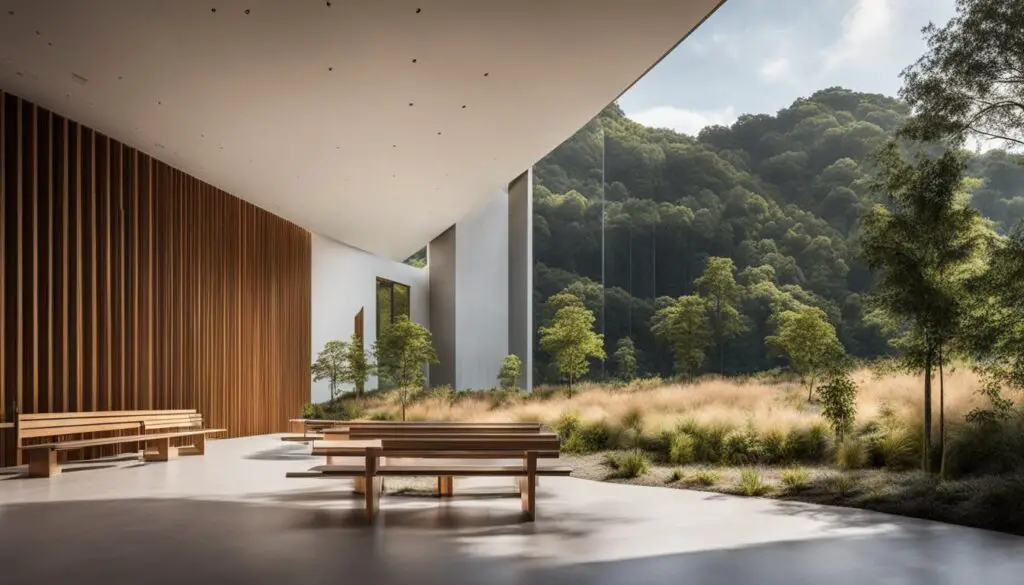
Contemporary Church Designs Around the World
Continuing the tradition of pushing boundaries and creating innovative spaces for worship, contemporary church designs around the world showcase the intersection of modern architecture and spiritual experience. These unique structures reflect the evolving needs and sensibilities of society, incorporating cutting-edge design principles while honoring the sacred purpose they serve.
One such remarkable example is the Bosjes Chapel in South Africa. This architectural marvel features a curvy white roof that appears to float above the glass facade, creating a sense of ethereal beauty. The surrounding water feature enhances the serene atmosphere, adding to the overall contemplative experience.
Another standout contemporary church design is the Community Church in Knarvik, Norway. Inspired by the traditional stave churches, this modern interpretation sits perched on a rock cliff, offering breathtaking views of the fjords. The innovative timber design pays homage to the local architectural heritage while embracing a minimalist aesthetic.
In contrast to these more traditional-inspired churches, the Pauluskerk in Rotterdam, the Netherlands, stands out with its bold and unconventional approach. Designed by Will Alsop, this multifaceted structure breaks away from traditional church aesthetics. Its bulky form and absence of a spire create a striking visual presence in the urban landscape, reflecting the intersection of modernity and spirituality.
Architectural Marvels in Modern Church Design
Modern church architecture has given rise to exceptional structures around the world that stand as testaments to innovation and design. Three remarkable examples of these architectural marvels are the Miho Chapel in Japan, the Våler kirke in Norway, and the El Señor de la Misericordia Church in Mexico.
The Miho Chapel, designed by renowned architect I.M. Pei, is a stunning fusion of stainless steel, glass, and timber. Its distinctive funnel-shaped exterior captivates the eye and draws visitors in. Inside, timber materials create a warm and serene atmosphere, offering a peaceful sanctuary for worship and contemplation.
The Våler kirke is a triumph of modern architecture and design. Winner of an architectural competition to replace a burnt-down church, it features a unique arrangement of vertical timber strips and two pyramidal roofs. This innovative design not only pays homage to traditional church aesthetics but also creates a striking visual impact against the Norwegian landscape.
The El Señor de la Misericordia Church seamlessly blends contemporary design elements with traditional Catholic features. Its grand and solemn structure commands attention and reverence. The church stands as a symbol of the intersection between modernity and spirituality, embracing the present while honoring timeless religious traditions.
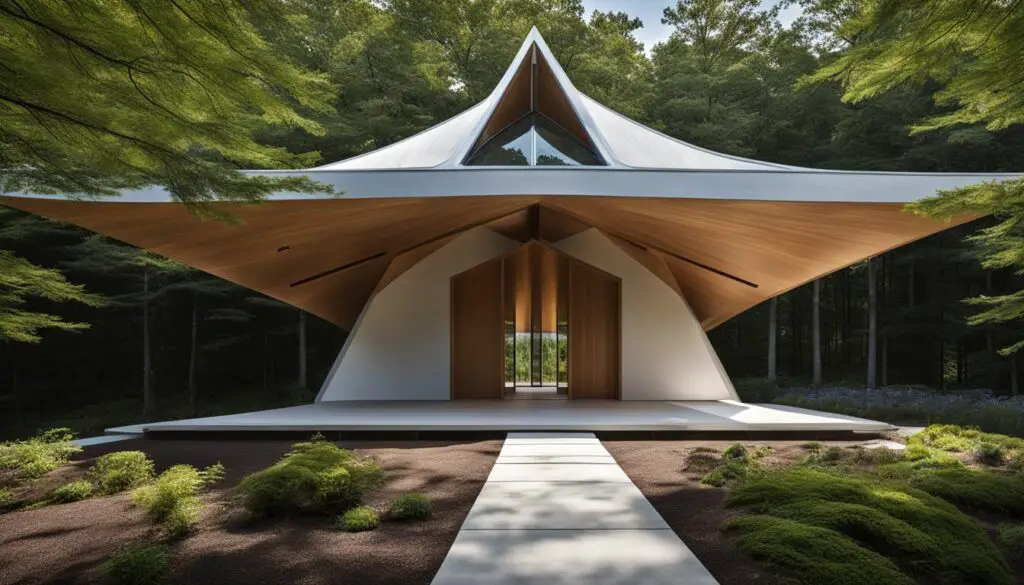
Notable Features of Architectural Marvels
The following table highlights the unique features of each architectural marvel:
| Church | Country | Architect | Distinctive Feature |
|---|---|---|---|
| Miho Chapel | Japan | I.M. Pei | Funnel-shaped stainless steel and glass exterior |
| Våler kirke | Norway | Various Architects | Vertical timber strips and two pyramidal roofs |
| El Señor de la Misericordia Church | Mexico | Various Architects | Combines contemporary design with traditional Catholic features |
“Modern church architecture pushes the boundaries of design and creates spaces that inspire awe and contemplation. The Miho Chapel, Våler kirke, and El Señor de la Misericordia Church are shining examples of the harmonious union between innovation and spirituality. These architectural marvels not only serve as places of worship but also as symbols of the creative and evolving nature of church design in the modern world.”
These architectural marvels showcase the remarkable possibilities when faith and design converge. They provide spaces that inspire and uplift, inviting both believers and visitors to experience the beauty and spirituality within their walls.
The Importance of Beauty in Church Architecture
Beauty has always been a significant aspect of church architecture. Throughout history, churches have been designed not just as places of worship but as awe-inspiring structures that inspire devotion, contemplation, and a sense of transcendence. One exemplary masterpiece that showcases the profound impact of beauty in church architecture is St Mary’s Church at Studley Royal in North Yorkshire, England.

St Mary’s Church at Studley Royal, designed by the renowned architect William Burges, is a testament to the power of beauty in religious spaces. Completed in 1870, this Victorian marvel combines intricate stonework, vibrant stained glass windows, and ornate decorations to create an atmosphere of splendor and reverence. The church’s stunning architecture, with its pointed arches, spires, and elaborate carvings, invites visitors to immerse themselves in the divine presence.
The impact of St Mary’s Church goes beyond its aesthetic appeal. Its grandeur and attention to detail evoke a sense of wonder and invite worshippers to connect with something greater than themselves. The beauty of this church serves as a visual representation of the divine and enhances the worship experience for all who enter its doors.
“I never expected to see anything so beautiful. The church is so lovely, so satisfying. It has a perfect harmony of parts, and everything is good in its kind.”
– John Betjeman, English poet and writer
Reviving Church Architecture for the Future
The book Making Dystopia by James Stevens Curl delves into the history of modern architecture and emphasizes the importance of reviving the architectural beauty of churches. Curl’s book English Victorian Churches: Architecture, Faith, & Revival aims to showcase the richness of England’s 19th-century church architecture and highlight its various styles. By studying and appreciating the history of church architecture, society can work towards reviving the beauty and meaning of these sacred spaces.
In Making Dystopia, Curl explores the negative consequences of modernist architectural movements that abandoned beauty and tradition. The book argues that this shift has resulted in the loss of the inherent spirituality and cultural significance that churches once possessed. Curl urges architects and designers to draw inspiration from the past in order to create innovative, yet spiritually meaningful, church designs for the future.
The English Victorian Churches: Architecture, Faith, & Revival book highlights the unique qualities and architectural splendor of Victorian churches. It showcases various examples of Victorian church designs, providing insights into the craftsmanship, aesthetics, and religious symbolism that defined this period. By understanding the significance of Victorian churches, architects can incorporate elements from the past while embracing modern design principles to create awe-inspiring spaces for worship and reflection.
| Making Dystopia | English Victorian Churches: Architecture, Faith, & Revival |
|---|---|
| Explores the history of modern architecture | Highlights the richness of Victorian church architecture |
| Emphasizes the importance of reviving architectural beauty | Provides insights into craftsmanship and aesthetics |
| Argues for a spiritually meaningful approach to design | Examines the religious symbolism of Victorian churches |
By studying the history of modern architecture and Victorian churches, architects and designers can find inspiration to create church designs that evoke a sense of beauty, spirituality, and cultural significance. Reviving the architectural traditions of the past while incorporating contemporary elements can result in innovative spaces that nourish the spirit and provide a sanctuary for worship in the future.
Unique Church Designs Beyond Traditional Notions
Contemporary church architecture often defies traditional notions and embraces unconventional forms and styles, pushing the boundaries of design. The St. George Jetson Church, located in the heart of the city, is a striking example of this modernist approach. Designed by renowned architect Jane Jetson, the church features a futuristic, spaceship-like structure that stands out in its urban surroundings. The sleek lines and innovative design elements make it a truly unique and iconic piece of architecture.
Another remarkable example is the Church of Knarvik in Norway. This contemporary church takes inspiration from the traditional stave churches of Norway but adds a modern twist. Perched on a rock cliff overlooking the majestic fjords, the Church of Knarvik features innovative timber design with a stunning combination of vertical strips and two pyramidal roofs. This architectural marvel not only blends seamlessly with its natural surroundings but also creates a spiritual and awe-inspiring space.
The Miho Institute of Aesthetics in Japan is yet another extraordinary church design that goes beyond traditional notions. The institute is home to the Miho Chapel, a masterpiece created by architectural genius I.M. Pei. The chapel’s exterior is characterized by a funnel-shaped stainless steel and glass structure, while the interior creates a warm and serene atmosphere with the use of timber materials. The Miho Chapel is a testament to the harmonious fusion of modernity and spirituality in contemporary church architecture.
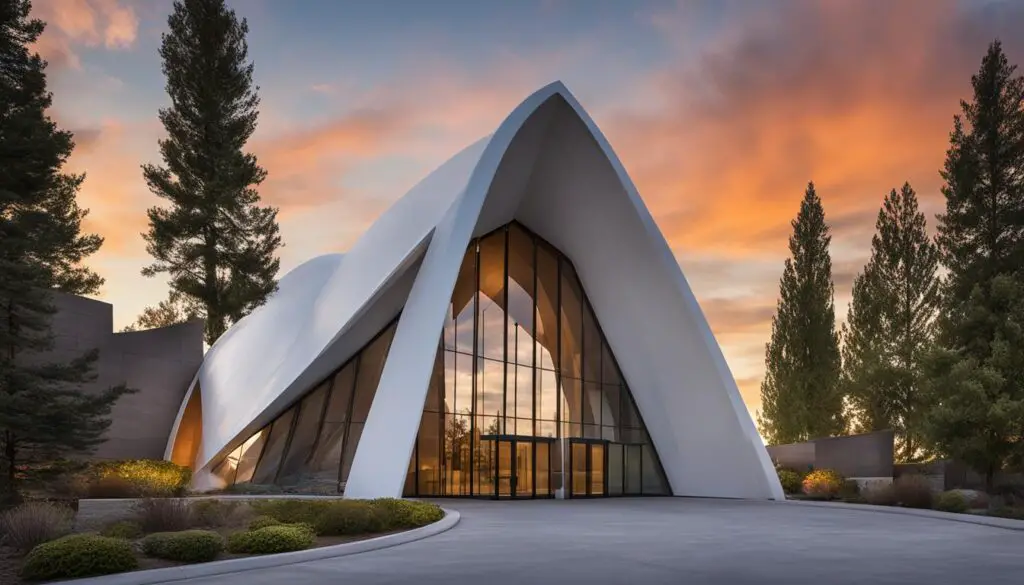
These examples highlight the innovative and captivating nature of modern church designs. By breaking away from traditional conventions, these architects and designers have created spaces that not only serve as places of worship but also engage with the modern world and push the boundaries of architectural expression.
The Intersection of Modernity and Spirituality
When it comes to modern church architecture, the intersection of modernity and spirituality is a fascinating and evolving phenomenon. Churches like the Pauluskerk in Rotterdam and the El Señor de la Misericordia Church in Monterrey, Mexico, exemplify this fusion of contemporary design and religious significance.
These contemporary structures deviate from traditional church aesthetics, embracing innovative designs that connect with the modern world while honoring and facilitating spiritual experiences. The Pauluskerk, for instance, breaks away from the conventional church silhouette with its bulky, multifaceted structure and the absence of a spire. It challenges the idea of what a church should look like, creating a space that reflects the dynamic nature of faith in the modern era.
The El Señor de la Misericordia Church in Monterrey, on the other hand, combines contemporary design elements with traditional Catholic features to create a grand and solemn structure. It celebrates the union of modernity and spirituality by incorporating cultural and architectural influences that resonate with both the local community and the broader faith community.

Table: A Comparison of Pauluskerk and El Señor de la Misericordia Church
| Church | Location | Architectural Style | Key Features |
|---|---|---|---|
| Pauluskerk | Rotterdam, Netherlands | Contemporary | Bulky, multifaceted structure Absence of spire |
| El Señor de la Misericordia Church | Monterrey, Mexico | Modern-Catholic | Combination of contemporary and traditional design elements Grand and solemn structure |
These churches demonstrate that modernity and spirituality can coexist in harmony, creating spaces that inspire awe, foster connection, and facilitate meaningful religious experiences. They are a testament to the evolving nature of church architecture and its ability to adapt to the ever-changing needs and sensibilities of society.
Celebrating the Union of Faith and Design
When it comes to modern church architecture, the Bosjes Chapel in South Africa and the Våler kirke in Norway stand as shining examples of the harmonious union between faith and design. These contemporary churches not only provide spaces for worship, but also serve as architectural masterpieces that inspire awe and elevate the worship experience.
The Bosjes Chapel, with its curvy white roof, glass facade, and surrounding water feature, creates a serene and ethereal atmosphere. The minimalist design allows natural light to flood the interior, creating a tranquil space for contemplation and reflection. Its striking aesthetic beautifully combines modern architectural principles with a deep sense of spirituality, making it a place of both physical and spiritual beauty.
Similarly, the Våler kirke in Norway showcases the innovative possibilities of modern church design. This unique structure, with its arrangement of vertical timber strips and two pyramidal roofs, pays homage to traditional Scandinavian architecture while embracing contemporary elements. Its open and inviting interior creates a sense of warmth and intimacy, providing a sacred space for worship and communion.
| Church | Location | Architectural Features |
|---|---|---|
| Bosjes Chapel | South Africa | Curvy white roof, glass facade, surrounding water feature |
| Våler kirke | Norway | Arrangement of vertical timber strips, two pyramidal roofs |
These churches demonstrate that modern design can enhance the spiritual experience by providing visually stunning spaces that evoke a sense of wonder and reverence. By celebrating the union of faith and design, the Bosjes Chapel and the Våler kirke inspire believers and visitors alike, reminding us of the power of architecture to uplift the soul and deepen our connection with the divine.
“Architecture is the learned game, correct and magnificent, of forms assembled in the light.” – Le Corbusier
Conclusion
Modern church architecture has evolved over time to reflect the changing needs and sensibilities of society. From mid-century modernist designs to contemporary innovations, modern churches have embraced a wide range of styles and approaches while remaining dedicated spaces for worship and contemplation.
The intersection of modernity, spirituality, and design in modern church architecture creates inspiring environments that inspire awe, foster meaningful connections, and nurture a sense of community. These architectural marvels blend the functionality and symbolism of religious spaces with the beauty and innovation of modern design.
By exploring the beauty of modern church architecture, we gain a deeper appreciation for the merging of faith and design. These spaces provide a sanctuary where worshippers can experience a connection with the divine while being surrounded by the inspiring elements of contemporary architecture. The combination of spiritual and aesthetic elements creates a profound and uplifting experience for individuals and communities alike.
FAQ
What influenced the shift towards modernist architecture in churches?
The shift towards modernist architecture in churches was influenced by the urgent building needs after the war, limited access to materials, the desire to show the modern world a socially acceptable face, and the belief that the Church should belong in the modern world.
What are some key features of modernist mid-century church architecture?
Modernist mid-century church architecture often incorporated blocks of concrete, raw materials, angular shapes, exposed structures, minimalist elements, sustainable design practices, and innovative building techniques.
Can modernist architecture and traditional elements coexist in church design?
Yes, some modern churches effectively blend modernist principles with traditional elements, such as altars, stained glass windows, and steeple-like structures, creating a unique aesthetic that appeals to both modern sensibilities and the desire for a connection to sacred traditions.
Are there any notable examples of mid-century modernist church architecture?
Yes, notable examples include the Church of the Holy Cross in Vienna, Austria, the Metropolitan Cathedral Liverpool in England, and the Council Memorial Church in Vienna. These buildings challenged traditional styles and embraced modernist principles of rationality, functionality, and technical innovation.
What are some contemporary church designs that push boundaries?
Contemporary church designs that push boundaries include the Bosjes Chapel in South Africa, the Community Church in Knarvik, Norway, the Pauluskerk in Rotterdam, the Miho Chapel in Japan, and the El Señor de la Misericordia Church in Mexico. These structures feature innovative forms, materials, and design approaches.
How does beauty impact church architecture and society?
The beauty of churches has a profound impact on the practice of religion and the overall health of society. It inspires awe, fosters a sense of community, and creates meaningful connections between individuals and their faith.
Are there any books that explore the history and importance of church architecture?
Yes, “English Victorian Churches: Architecture, Faith, & Revival” by James Stevens Curl explores the history of Victorian churches and their impact on society. Another book by James Stevens Curl, “Making Dystopia,” discusses the history of modern architecture and emphasizes the importance of reviving the architectural beauty of churches.
How can modern church architecture be revived for the future?
By studying and appreciating the history of church architecture, society can work towards reviving the beauty and meaning of these sacred spaces. This can involve incorporating innovative designs, sustainable practices, and a fusion of modern and traditional elements.
Can modern church designs deviate from traditional aesthetics?
Yes, contemporary church designs often challenge traditional notions of what a church should look like. Examples include the St. George Jetson Church, the Miho Institute of Aesthetics in Japan, and the Church of Knarvik in Norway, which reimagine traditional forms and architectural styles.
How do modern church designs balance modernity and spirituality?
Modern church designs like the Pauluskerk in Rotterdam and the El Señor de la Misericordia Church in Mexico exemplify the fusion of modernity and spirituality. These structures deviate from traditional aesthetics but still serve as spaces for religious rituals and reflection, creating innovative designs that connect with the modern world while honoring and facilitating spiritual experiences.
Can contemporary church designs celebrate the union of faith and design?
Yes, churches like the Bosjes Chapel in South Africa and the Våler kirke in Norway exemplify the celebration of the union between faith and design. These contemporary churches provide awe-inspiring spaces that enhance worship experiences while embracing modern architectural design principles.

